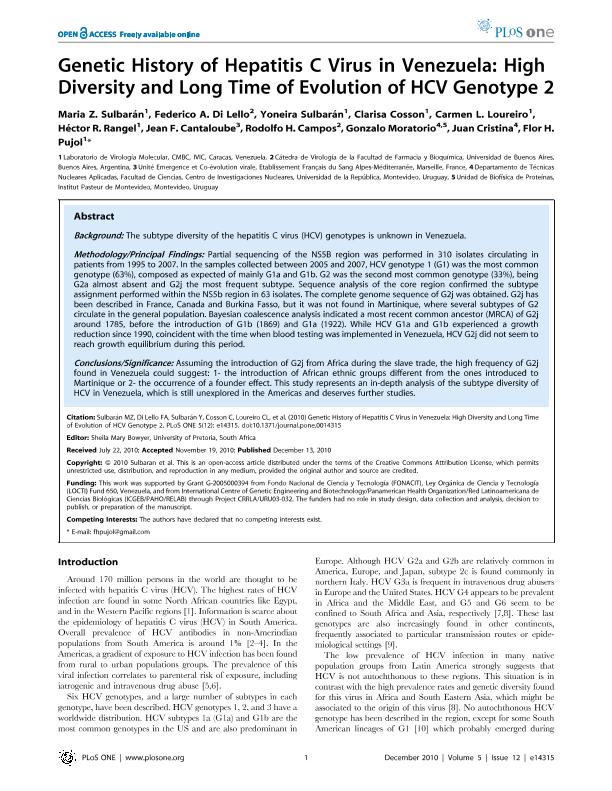Mostrar el registro sencillo del ítem
dc.contributor.author
Sulbarán, Maria Z.
dc.contributor.author
Di Lello, Federico Alejandro

dc.contributor.author
Sulbarán, Yoneira
dc.contributor.author
Cosson, Clarisa
dc.contributor.author
Loureiro, Carmen
dc.contributor.author
Rangel, Héctor R.
dc.contributor.author
Cantaloube, Jean F.
dc.contributor.author
Campos, Rodolfo Hector

dc.contributor.author
Moratorio, Gonzalo
dc.contributor.author
Cristina, Juan
dc.contributor.author
Pujol, Flor H.
dc.date.available
2017-03-22T19:25:34Z
dc.date.issued
2010-12
dc.identifier.citation
Sulbarán, Maria Z.; Di Lello, Federico Alejandro; Sulbarán, Yoneira; Cosson, Clarisa; Loureiro, Carmen; et al.; Genetic history of Hepatitis C virus in Venezuela: high diversity and long time of evolution of HCV genotype 2; Public Library Of Science; Plos One; 5; 12; 12-2010; 5-14315
dc.identifier.issn
1932-6203
dc.identifier.uri
http://hdl.handle.net/11336/14200
dc.description.abstract
Background: The subtype diversity of the hepatitis C virus (HCV) genotypes is unknown in Venezuela. Methodology/Principal Findings: Partial sequencing of the NS5B region was performed in 310 isolates circulating in patients from 1995 to 2007. In the samples collected between 2005 and 2007, HCV genotype 1 (G1) was the most common genotype (63%), composed as expected of mainly G1a and G1b. G2 was the second most common genotype (33%), being G2a almost absent and G2j the most frequent subtype. Sequence analysis of the core region confirmed the subtype assignment performed within the NS5b region in 63 isolates. The complete genome sequence of G2j was obtained. G2j has been described in France, Canada and Burkina Fasso, but it was not found in Martinique, where several subtypes of G2 circulate in the general population. Bayesian coalescence analysis indicated a most recent common ancestor (MRCA) of G2j around 1785, before the introduction of G1b (1869) and G1a (1922). While HCV G1a and G1b experienced a growth reduction since 1990, coincident with the time when blood testing was implemented in Venezuela, HCV G2j did not seem to reach growth equilibrium during this period. Conclusions/Significance: Assuming the introduction of G2j from Africa during the slave trade, the high frequency of G2j found in Venezuela could suggest: 1- the introduction of African ethnic groups different from the ones introduced to Martinique or 2- the occurrence of a founder effect. This study represents an in-depth analysis of the subtype diversity of HCV in Venezuela, which is still unexplored in the Americas and deserves further studies.
dc.format
application/pdf
dc.language.iso
eng
dc.publisher
Public Library Of Science

dc.rights
info:eu-repo/semantics/openAccess
dc.rights.uri
https://creativecommons.org/licenses/by/2.5/ar/
dc.subject
Viral Evolution
dc.subject
Viral Epidemiology
dc.subject
Hepatitis C Virus
dc.subject.classification
Epidemiología

dc.subject.classification
Ciencias de la Salud

dc.subject.classification
CIENCIAS MÉDICAS Y DE LA SALUD

dc.title
Genetic history of Hepatitis C virus in Venezuela: high diversity and long time of evolution of HCV genotype 2
dc.type
info:eu-repo/semantics/article
dc.type
info:ar-repo/semantics/artículo
dc.type
info:eu-repo/semantics/publishedVersion
dc.date.updated
2017-03-21T20:14:11Z
dc.journal.volume
5
dc.journal.number
12
dc.journal.pagination
5-14315
dc.journal.pais
Estados Unidos

dc.journal.ciudad
San Francisco
dc.description.fil
Fil: Sulbarán, Maria Z.. Instituto Venezolano de Investigaciones Cientificas; Venezuela
dc.description.fil
Fil: Di Lello, Federico Alejandro. Consejo Nacional de Investigaciones Científicas y Técnicas; Argentina. Universidad de Buenos Aires. Facultad de Farmacia y Bioquímica. Departamento de Microbiología, Inmunología y Biotecnología. Cátedra de Virología; Argentina
dc.description.fil
Fil: Sulbarán, Yoneira. Instituto Venezolano de Investigaciones Cientificas; Venezuela
dc.description.fil
Fil: Cosson, Clarisa. Instituto Venezolano de Investigaciones Cientificas; Venezuela
dc.description.fil
Fil: Loureiro, Carmen. Instituto Venezolano de Investigaciones Cientificas; Venezuela
dc.description.fil
Fil: Rangel, Héctor R.. Instituto Venezolano de Investigaciones Cientificas; Venezuela
dc.description.fil
Fil: Cantaloube, Jean F.. Etablissement Français du Sang Alpes-Méditerranée. Unité Emergence et Co-évolution virale; Francia
dc.description.fil
Fil: Campos, Rodolfo Hector. Consejo Nacional de Investigaciones Científicas y Técnicas; Argentina. Universidad de Buenos Aires. Facultad de Farmacia y Bioquímica. Departamento de Microbiología, Inmunología y Biotecnología. Cátedra de Virología; Argentina
dc.description.fil
Fil: Moratorio, Gonzalo. Universidad de la Republica; Uruguay. Instituto Pasteur de Montevideo; Uruguay
dc.description.fil
Fil: Cristina, Juan. Universidad de la Republica; Uruguay
dc.description.fil
Fil: Pujol, Flor H.. Instituto Venezolano de Investigaciones Cientificas; Venezuela
dc.journal.title
Plos One

dc.relation.alternativeid
info:eu-repo/semantics/altIdentifier/doi/http://dx.doi.org/10.1371/journal.pone.0014315
dc.relation.alternativeid
info:eu-repo/semantics/altIdentifier/url/http://journals.plos.org/plosone/article?id=10.1371/journal.pone.0014315
Archivos asociados
